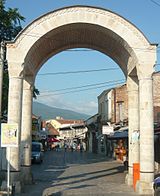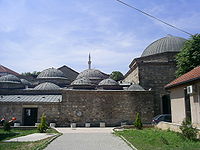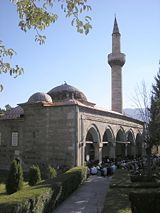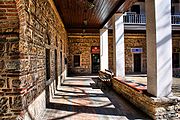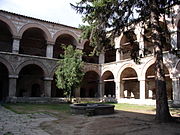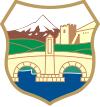- Old Bazaar, Skopje
-
The Old Bazaar (Macedonian: Стара Чаршија, Stara Čaršija from the Turkish: Çarşı meaning marketplace, Albanian: Çarshia e Vjetër) in Skopje is the largest bazaar in the Balkans outside Istanbul.[1] Situated on the eastern bank of the Vardar River, the bazaar had been the city's centre for trade and commerce since at least the 12th century.[2] It rapidly grew and reached its peak during Ottoman rule, evidenced by over 30 mosques, several caravanserais, and other Turkish buildings and monuments. The commerce hub of Skopje has since become Centar Municipality, just across the river. Although Islamic architecture is predominant in the bazaar, there are several churches as well.
Today, the Old Bazaar falls within the borders of Čair Municipality and is a protected national landmark.[3]
Contents
History
Archaeological evidence found at Kale Fortress suggests that Skopje's Old Bazaar could have been inhabited as early as 4000 BC, while the earliest historical records suggest that it was first inhabited in the 6th century BC, perhaps by Paeonians.[4]
Byzantine Emperor Justinian I constructed Kale Fortress in the 6th century, on a hill located in what would eventually become the Old Bazaar.
The area became a major trading centre in the 12th century.[2]
In 1392, Macedonia was conquered by Ottoman Turks and named Skopje Üsküp. It was under the Ottoman Empire that the Old Bazaar reached its peak of significance and became an important economic centre.
The city soon became predominantly Muslim and the cityscape changed accordingly; countless mosques, caravanserais, hamams, and other Islamic buildings sprang up in the city. Many pre-existing churches were seized and converted to mosques. An earthquake in 1555 caused much destruction. The city, however, continued to grow.[4]
The Old Bazaar today is located in Skopje's Čair Municipality. Of the 64,773 inhabitants, over half are ethnic Albanians, roughly one-quarter are Macedonians, 7% are Turks, and the remaining population is composed of Roma and Bosniaks.[5]
Several of the historic buildings of the Old Bazaar are now used as museums.
Landmarks
Bezisten
Skopje's bezisten, a covered market, was built in the 15th century by Gazi Ishak Bey, the Sultan's Skopje regent. It was destroyed by a fire in 1689 and was later rebuilt. The bezisten has looked the same since its renovation in 1899.[6]
Clock tower
Skopje's clock tower, built in the 16th century on the foundations of an older edifice, is located just north of the Sultan Murad Mosque. Originally built of wood, the top was replaced with bricks in 1902.[7]
The hexagonal tower was heavily damaged during the 1963 earthquake. It was soon fully repaired.[6]
Çifte Hamam
Main article: Čifte HammamThe Çifte Hamam (Turkish for 'double bath'), located in the centre of the old bazaar, was built in the 15th century under Isa Bey. The building is divided into two wings (hence the name 'double'): one for men and one for women. The layout of both sections are nearly identical.[8]
The Çifte Hamam was used as a bathhouse until 1915. After suffering damages during the 1963 earthquake, it was repaired and has housed the Contemporary Art Gallery since then.[9]
Daut Paşa Hamam
Daut Paşa, Grand Vesir of East Rumelia, constructed this hamam in the 15th century. The building consists of fifteen rooms covered by thirteen domes. The two largest domes covered the two changing rooms and the rest of the domes covered individual bathing rooms.[10]
Since 1948, the Daut Paşa Hamam has housed the National Art Gallery.[6]
Isa Bey Mosque
Situated on the outskirts of the bazaar, this mosque was built as a memorial for Isa Bey after his death. The mosque has two dominant domes and five smaller ones above the porch area.[6]
Ishak Bey Mosque
Also known as the Decorated (Aladya) Mosque because of the floral decorations, inscriptions and coloured tiles found on its walls, the Ishak Bey Mosque was constructed in 1439 in the northern part of the Old Bazaar. The mosque's minaret rises 30 meters (98.4 feet).
Ishak Bey, who retired in the city, is buried in the türbe behind the mosque.[11]
Kale Fortress
Main article: Skopje FortressLocated on the highest hill in Skopje, overlooking the city and the river, the area upon which the fortress was built was first inhabited in prehistoric times, according to archaeological findings.[4]
Most researchers believe that the fortress was first constructed in the 11th century.[4]
Kapan Han
Main article: Kapan HanOne of the three remaining caravanserais in the Old Bazaar, the Kapan Han was built in the 15th century. The rooms in the upper floor were available to guests, while the ground floor was used as a stable to house the guests' horses and cattle.[12]
Kurşumli Han
The largest of the three remaining caravanserais, the Kurşumli Han (Turkish for 'Lead Inn') was built by Musein Odza, the son of a scientist at Sultan Selim II’s court, in the 16th century.[13]
The roof of the inn was once covered in lead (hence the name), but was removed during World War I. The Kurşumli Han also has several small pyramidically-shaped domes. The building has a ground floor, which housed the cattle and horses, and a first floor, which housed the guests.[6]
The attached mosque, built in the 17th century, and most of the hamam, built in the 15th century, were destroyed in the 1963 earthquake.
Today, the former han houses the statue collection of the Museum of Macedonia.[14]
Mustafa Paşa Mosque
Main article: Mustafa Paşa MosqueThe Mustafa Paşa Mosque, built in 1492 by Mustafa Paşa on an older Christian site,[15] stands above the Old Bazaar, near Kale Fortress. Considered one of the most elegant Islamic buildings in Macedonia, the complex includes the mosque, the tomb of Mustapha Paşa, the sarcophagus of one of his daughters, a fountain, and remnants of other buildings.
The mosque is square in shape and its largest dome is 16 metres (52.5 feet) in diameter. The porch is positioned on four marble pillars, decorated with stalactite, and covered by three small domes. The interior is decorated and includes calligraphic inscriptions. The minaret of Mustafa Paşa Mosque, rising 42 metres (137.8 feet)[16] is made of limestone.
Mustafa Paşa is buried in the hexagonal marble türbe covered by a dome above a short eight-sided tambour. Umi, one of his four daughters, is buried in the decorated sarcophagus which includes Persian inscriptions on two of the four walls. The mosque courtyard is filled with roses and, due to its elevated location, offers a distinct view of the Old Bazaar.[6]
St. Spas Church
Constructed in the 17th century on the foundations of an older church,[17] half of the church was built underground as it was illegal under Ottoman rule for Christian buildings to be taller than Islamic buildings so mosques could dominate the city skyline. The church got its present appearance in the 19th century.
The church's iconstasis was carved in wood and is 10 metres (32.8 feet) long, 4.5 to 7 metres (14.8 to 23 feet) in height.[6]
Revolutionary Goce Delčev is buried in a white stone sarcophagus in the church's courtyard.[18]
Stone Bridge
Main article: Stone Bridge (Skopje)The Stone Bridge, across the Vardar River, connects the Old Bazaar to Macedonia Square in the new part of the city. The bridge, built in the 15th century under Sultan Murad, was built of stone blocks as its name suggests, which has helped it survive the fires and earthquakes Skopje has seen. The Stone Bridge has had the same appearance since it was first built.[6]
The bridge has 12 semicircular arches and is 214 metres (702 feet) long. During Ottoman rule, countless executions were conducted on the Stone Bridge.[19]
Suli Han
Main article: Suli AnThe Suli Han was built under Ishak Bey in the 15th century. It has two floors with the upper having 54 rooms for the guests and the lower for the guests' cattle. It was fully repaired after sustaining heavy damaged during the 1963 earthquake.[20]
The han today houses the Skopje Academy of Art and the Old Bazaar Museum.[6]
Sultan Murad Mosque
Main article: Sultan Murad MosqueSultan Murad built this mosque in 1463, just south of where the clock tower would be built. The mosque has remained mostly undamaged through the fires and earthquakes Skopje has sustained.
The Sultan Murad Mosque is rectangular in shape, with a porch including four columns with decorated caplets, connected by arcades.[6]
Yahya Paşa Mosque
The Yahya Paşa Mosque was built in 1504 for Yahya Paşa.[21] During World War I, the mosque was used as a German weapons and ammunition production facility.
The mosque's minaret is roughly 50 metres (164 feet) tall. There are several tombs and a burial chamber in the Yahya Paşa Mosque's courtyard.[6]
Gallery
-
Türbe at Ishak Bey Mosque
-
Goce Delčev's tomb at St. Spas
Historical
See also
- Bazaar
- Ottoman-era Republic of Macedonia
- Economy of the Republic of Macedonia
References
- ^ Balkan Travellers
- ^ a b Macedonia National Tourism Portal
- ^ SETimes
- ^ a b c d skopje.mk
- ^ Macedonian census data of 2002
- ^ a b c d e f g h i j k http://www.culture.org.mk/eskopje%20frames.htm
- ^ GoMacedonia
- ^ skopje.mk
- ^ In Your Pocket
- ^ In Your Pocket
- ^ In Your Pocket
- ^ In Your Pocket
- ^ skopje.mk
- ^ In Your Pocket
- ^ GoMacedonia
- ^ In Your Pocket
- ^ Soros
- ^ Exploring Macedonia
- ^ GoMacedonia
- ^ skopje.mk
- ^ Macedonia.co.uk
Coordinates: 42°00′03″N 21°26′13″E / 42.000756°N 21.436955°E
Categories:- Ottoman architecture
- Buildings and structures in Skopje
- Bazaars
- Economy of the Republic of Macedonia
- Macedonia under the Ottoman Empire
Wikimedia Foundation. 2010.


